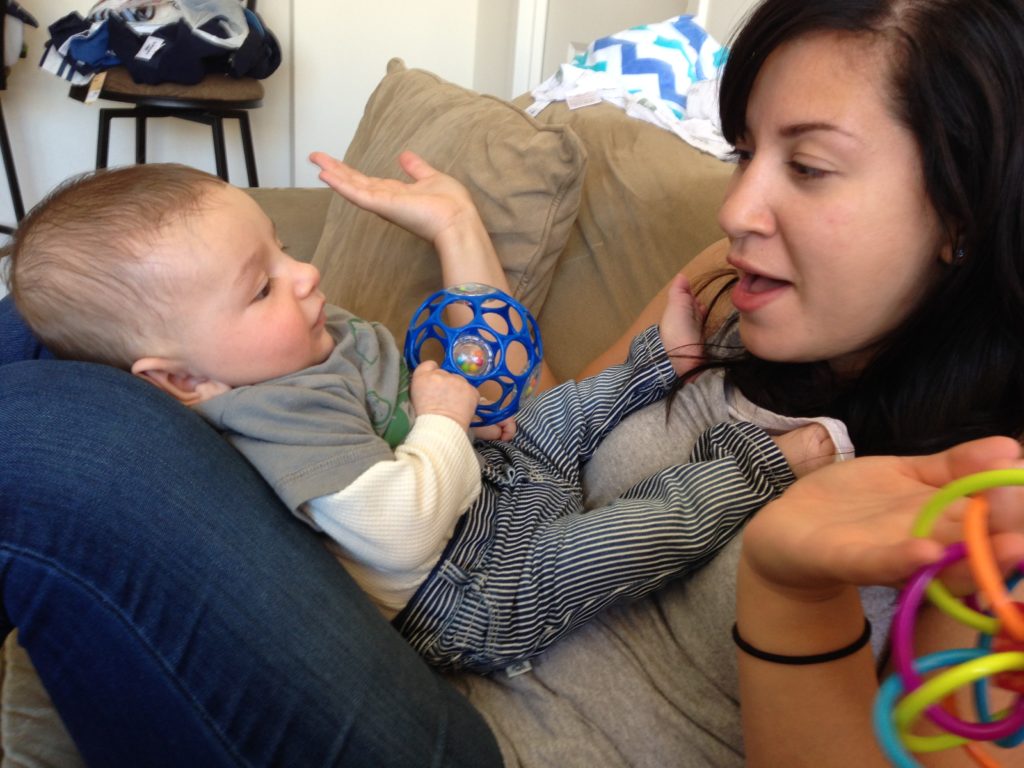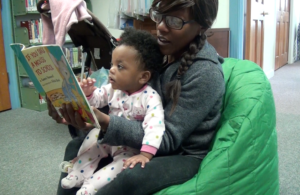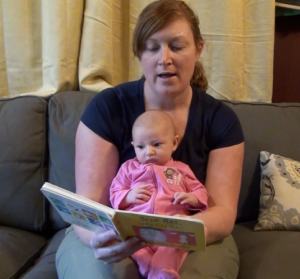
Of all the senses, hearing is the most well-developed at birth, providing one of the best opportunities to stimulate new babies and introduce their world to them. The development of hearing in newborns is so acute and rapid that by the age of five months, infants are typically able to determine the difference between two adjacent keys on a piano. Since the auditory parts of the brain are so well-developed at birth, and continue to develop so rapidly, babies are hearing just as well as full grown adults by eight months, because that part of the brain is fully “wired.”
Unlike vision, hearing is very developed even before birth, as babies are able to hear in utero. Some experts believe that babies are able to hear for about 24 weeks before birth. Your baby was constantly stimulated by the sounds, movement, and vibration of the amniotic fluid, placenta, walls of the uterus, and the sound and vibration of mommy’s voice. I know that my babies responded to me reading and singing to them by increasing their movement in utero, and studies show the same. Babies in utero typically have a faster heart rate when they hear their mother’s voice.
When babies are born, they are able to hear well, but not perfectly. The middle ear is still not completely mature and often babies have some fluid in the inner ear from the birth process, which affects their hearing slightly. This slightly diminished hearing reception is why babies are able to hear higher pitches and frequencies better than other sounds. Incidentally babies prefer their mother’s voice to any other sound. This is both because of familiarity and because usually women speak in higher frequencies than men. What a great opportunity to use our voice to build those important connections in the brain. Simply by reading, singing, and talking to our babies, we are stimulating brain cells and aiding in their motor and cognitive development.
Music is another great way to build those important connections. Because music is perceived with both  sides of the brain, stimulating the corpus callosum (the neural fibers that connect the two sides of the brain together) a large part of the brain is stimulated while processing music, and the two sides of the brain start to learn to work together. This is important for motor skills, coordination, and higher level thinking and reasoning. Listening to music also helps babies comprehend and eventually speak language. There are a lot of similarities between music and language, no matter what language you are speaking, because of the variations in rhythm, tone, inflection, and volume. Babies’ brains are primed to respond to these aspects of auditory stimulation. Another really cool thing is that the areas of the brain that are responsible for language and music exist side by side, and develop with the same nerve pathway, so by exposing your child to music, you are also developing their language skills. Another cool anatomical thing about the brain is the mechanisms for balance are also housed in the inner ear, so auditory stimulation helps to develop your baby’s sense of balance as well. It certainly does not have to be Mozart. Any music will have the same effect, but studies have shown that more complicated patterns of music are more stimulatory to the brain. Just make sure it is music that you enjoy. Remember, your baby joins your family.
sides of the brain, stimulating the corpus callosum (the neural fibers that connect the two sides of the brain together) a large part of the brain is stimulated while processing music, and the two sides of the brain start to learn to work together. This is important for motor skills, coordination, and higher level thinking and reasoning. Listening to music also helps babies comprehend and eventually speak language. There are a lot of similarities between music and language, no matter what language you are speaking, because of the variations in rhythm, tone, inflection, and volume. Babies’ brains are primed to respond to these aspects of auditory stimulation. Another really cool thing is that the areas of the brain that are responsible for language and music exist side by side, and develop with the same nerve pathway, so by exposing your child to music, you are also developing their language skills. Another cool anatomical thing about the brain is the mechanisms for balance are also housed in the inner ear, so auditory stimulation helps to develop your baby’s sense of balance as well. It certainly does not have to be Mozart. Any music will have the same effect, but studies have shown that more complicated patterns of music are more stimulatory to the brain. Just make sure it is music that you enjoy. Remember, your baby joins your family.
Tips for hearing development:
- Read to your baby; encourage him to look at the pictures and help you turn the pages.
- Provide as much music with varying sounds, pitches, and rhythm as you can.
- Sing to your baby as much as possible.
- Help baby link two senses together by associating sound and vision. Allow baby to play with toys that also make noise, such as rattles and musical instruments.
- Talk to baby often so that they learn to process language and begin to understand the flow of a conversation.
- Use rattle booties and rattle wrist bands to help teach your baby body awareness.
- Encourage your baby to make their own noise by rubbing items together, knocking on surfaces, tapping their hands and feet.
- Have other children talk to your baby. Babies are fascinated by children and their higher pitch voices are easy for babies to interpret.
- Encourage your baby to babble and make sounds with their mouth. It is an early form of language.
 It is important to note that although hearing is the best-developed sense at birth, hearing loss is the most common congenital condition in the United States. According to the American Academy of Pediatrics, an estimated three in 1000 infants are born in the US with moderate, severe, or profound hearing loss every year. Because of this high percentage, all states have implemented newborn hearing screens to be done in hospitals and birthing centers prior to discharge. Studies have shown that children identified with hearing loss prior to six-months of age have a better chance of developing skills equivalent to their peers by the time they enter kindergarten. Children not identified until later may suffer from irreversible and permanent impairments in speech, language, and cognitive abilities.
It is important to note that although hearing is the best-developed sense at birth, hearing loss is the most common congenital condition in the United States. According to the American Academy of Pediatrics, an estimated three in 1000 infants are born in the US with moderate, severe, or profound hearing loss every year. Because of this high percentage, all states have implemented newborn hearing screens to be done in hospitals and birthing centers prior to discharge. Studies have shown that children identified with hearing loss prior to six-months of age have a better chance of developing skills equivalent to their peers by the time they enter kindergarten. Children not identified until later may suffer from irreversible and permanent impairments in speech, language, and cognitive abilities.
Risk factors for congenital hearing loss include: babies whose mothers suffered from illness during pregnancy; babies who had a family history of hearing loss, or those who were exposed to drugs known to affect hearing; low birth weight and/or prematurity, or oxygen deprivation or breathing difficulties at birth; high bilirubin levels; syndromes associated with hearing loss; abnormal head or face structures; infections such as syphilis and herpes, or low apgar scores (test which assess several health factors at one minute and again at five minutes after birth).
Have fun with your baby’s wonderful sense of hearing, because as a mother of teenagers, I can promise you, they won’t listen to your forever!
References:
Aamodt, S. & Wang, S. (2011). Welcome to Your Child’s Brain: How the Mind Grows from Conception to College. Bloomsbury, NY.
American Academy of Pediatrics. (2018). https://www.aap.org/en-us/advocacy-and-policy/aap-health-initiatives/PEHDIC/Pages/Early-Hearing-Detection-and-Intervention.aspx
Suskind, D. (2015). Thirty Million Words: Building A Child’s Brain. Random House.

